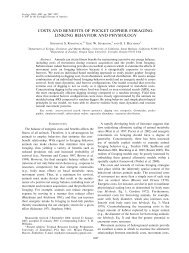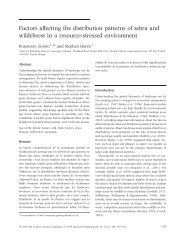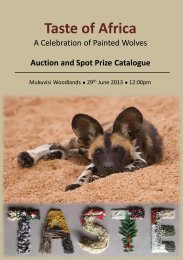The feeding ecology of the aardvark Orycteropus afer - ResearchGate
The feeding ecology of the aardvark Orycteropus afer - ResearchGate
The feeding ecology of the aardvark Orycteropus afer - ResearchGate
You also want an ePaper? Increase the reach of your titles
YUMPU automatically turns print PDFs into web optimized ePapers that Google loves.
150 W. A. TAYLOR ET AL.study. <strong>The</strong> Formicines were highly preferred, while <strong>the</strong> Myrmicines were under-utilized,conforming to <strong>the</strong> findings <strong>of</strong> Redford (1987). <strong>The</strong> abundance <strong>of</strong> prey has beensuggested as an important factor in determining prey choice in myrmecophagousmammals (Redford, 1987; Abensperg-Traun, 1990). In <strong>the</strong> present study, abundancewas found to be predictive <strong>of</strong> utilization by <strong>aardvark</strong>s in winter, but not summer. Somespecies were not utilized in proportion to <strong>the</strong>ir abundance. T. trinervoides andM. albopilosum were both under-utilized relative to A. custodiens.Aardvark forage in a haphazard manner, and this makes it likely that prey speciesabundance is important in determining <strong>the</strong>ir diet selection. For example, A. custodiens ismore widespread and numerous at TdR than A. steingroeveri (Lindsey & Skinner, 2001)and, if no preferential selection occurs between <strong>the</strong> two species, A. custodiens should beutilized more. This is indeed <strong>the</strong> case. In fact all <strong>the</strong> species <strong>of</strong> major importance in <strong>the</strong>diet <strong>of</strong> <strong>the</strong> <strong>aardvark</strong>s at TdR are extremely abundant in <strong>the</strong> area.Prey mobility was predictive <strong>of</strong> prey utilization in both seasons. <strong>The</strong> mobility <strong>of</strong>a species has <strong>the</strong> potential to rapidly reduce <strong>the</strong> value <strong>of</strong> a ‘prey patch’ (Abensperg-Traun, 1990) and encourage <strong>the</strong> <strong>aardvark</strong> to move to a fresh site. <strong>The</strong> high mobility <strong>of</strong>H. mossambicus and A. custodiens, for example, rapidly reduces <strong>the</strong> prey density at <strong>the</strong><strong>feeding</strong> site. This seems to be a plausible explanation for <strong>the</strong> fact that <strong>aardvark</strong>sfrequently leave <strong>feeding</strong> sites despite <strong>the</strong> presence <strong>of</strong> hundreds <strong>of</strong> ants around <strong>the</strong> nestexit. <strong>The</strong> <strong>aardvark</strong>s tongue is vermiform, adapted for insertion into holes and tunnels,not for lapping up ants from <strong>the</strong> surface. As a result, once <strong>the</strong> ants have dispersed from<strong>the</strong> tunnel <strong>the</strong>y are largely unavailable to <strong>the</strong> <strong>aardvark</strong>. In contrast, <strong>the</strong> low mobility <strong>of</strong>T. trinervoides is probably a major reason behind <strong>the</strong> length <strong>of</strong> feeds upon <strong>the</strong> mounds.Prey size was predictive <strong>of</strong> prey utilization in winter but not in summer, even thoughmost <strong>aardvark</strong> prey in summer were large. As <strong>the</strong> prey species have similar calorificvalues per unit mass it might be expected that <strong>the</strong> size <strong>of</strong> <strong>the</strong> various prey species wouldbe significant in prey choice. Greater calorific gains per ant would be achieved fromlarger ants.Prey defence was not found to be predictive <strong>of</strong> prey utilization in <strong>the</strong> present studyalthough it has been found to be important in a number <strong>of</strong> o<strong>the</strong>r myrmecophages,including <strong>the</strong> pangolin Manis temminckii (Swart, 1996), <strong>the</strong> giant anteaterMyrmecophaga tridactyla (Redford, 1985), <strong>the</strong> vermilinguas Cyclopes didactylus andTamandua mexicana (Montgomery, 1985), and <strong>the</strong> echidna Tachyglossus aculeatus(Abensperg-Traun, 1990). Prey defences may cause irritation and premature cessation<strong>of</strong> <strong>feeding</strong> bouts in a number <strong>of</strong> species (Redford, 1987). It has been suggested that <strong>the</strong>preference <strong>of</strong> myrmecophages for formicines over myrmicines can be explained in terms<strong>of</strong> prey defences.<strong>The</strong> only prey species to visibly cause <strong>the</strong> <strong>aardvark</strong>s discomfort during <strong>feeding</strong> wasD. helvolus. <strong>The</strong> rest, including A. custodiens and H. mossambicus, which are recorded ascausing discomfort to pangolins (Swart, 1996), did not appear to affect <strong>the</strong><strong>aardvark</strong>s. <strong>The</strong> defences <strong>of</strong> T. trinervoides did not deter <strong>aardvark</strong>s ei<strong>the</strong>r. <strong>The</strong> hardmounds <strong>of</strong> this termite are an effective barrier to o<strong>the</strong>r myrmecophages, including<strong>the</strong> aardwolf (Richardson, 1987) and pangolin (Swart, 1996), but <strong>the</strong> <strong>aardvark</strong> is able todig into <strong>the</strong>m with consummate ease. <strong>The</strong> chemical defences <strong>of</strong> T. trinervoides soldiersdo not prevent predation by <strong>aardvark</strong>s ei<strong>the</strong>r, despite suggestions to <strong>the</strong> contrary(Richardson, 1987, 1994; Anderson, 1994). <strong>The</strong> proportions <strong>of</strong> soldier T. trinervoides in<strong>aardvark</strong> faeces were significantly higher than proportions in mounds, indicating that <strong>the</strong><strong>aardvark</strong> is not too careful to avoid <strong>the</strong>ir ingestion. <strong>The</strong>refore, <strong>the</strong> effect <strong>of</strong> preydefences upon <strong>the</strong> <strong>feeding</strong> patterns <strong>of</strong> <strong>the</strong> <strong>aardvark</strong> appears limited.<strong>The</strong> effect <strong>of</strong> prey defences may be reduced by certain behavioural characteristics<strong>of</strong> <strong>aardvark</strong>. First, on reaching prey nests <strong>the</strong>y dig rapidly and feed frantically, enablingprey consumption to occur before <strong>the</strong> concentration <strong>of</strong> soldiers can increase significantly.Secondly, frequent digging during <strong>feeding</strong> probably has <strong>the</strong> effect <strong>of</strong> removingany build up <strong>of</strong> soldiers. Thirdly, <strong>aardvark</strong>s do not chew <strong>the</strong>ir food (aside from





